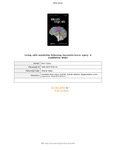Living with suicidality following traumatic brain injury: A qualitative study
| dc.contributor.author | Knight, E | |
| dc.contributor.author | Norman, Alyson | |
| dc.contributor.author | Simpson, G | |
| dc.date.accessioned | 2020-05-01T17:04:24Z | |
| dc.date.issued | 2020-06-12 | |
| dc.identifier.issn | 0269-9052 | |
| dc.identifier.issn | 1362-301X | |
| dc.identifier.uri | http://hdl.handle.net/10026.1/15624 | |
| dc.description.abstract |
PURPOSE: Numbers of traumatic brain injury (TBI) are increasing, and with suicidality post-injury presenting at 3-4 times higher than in the general population, understanding this is crucial in reducing a devastating outcome. Given the lack of literature, this study investigated the experiences of living with suicidality after TBI. METHODS: Interview data from nineteen participants with TBI from a Brain Injury Rehabilitation Unit (BIRU) in New South Wales (NSW), Australia were collected and thematically analyzed. FINDINGS: The participants (predominantly male) sustained extremely severe injuries (median PTA 60 [IQR 81.0] days) and were in the chronic phase post-injury (median 8.0 [IQR 9.0] years). Six main themes were identified; Loss of sense of self, TBI as a hidden disability, Chronic but transient suicidality, Reliance, Protective factors, and Hope. Tentative relationships between themes and subthemes were identified. CONCLUSION: Chronic suicidality after TBI was demonstrated consistently regardless of receiving long-term support. However, their engagement with protective factors such as social support, spirituality and positive personal qualities was identified. Implementing these as coping strategies during long-term rehabilitation may reduce the levels of suicidal distress. Implications, methodological considerations and future research were discussed, with the aim of improving experiences of individuals with TBI to reduce suicidality. | |
| dc.format.extent | 1010-1019 | |
| dc.format.medium | Print-Electronic | |
| dc.language | en | |
| dc.language.iso | en | |
| dc.publisher | Taylor & Francis | |
| dc.subject | Traumatic Brain Injury | |
| dc.subject | suicide | |
| dc.subject | suicide ideation | |
| dc.subject | hopelessness | |
| dc.subject | lived experience | |
| dc.subject | protective factors | |
| dc.title | Living with suicidality following traumatic brain injury: A qualitative study | |
| dc.type | journal-article | |
| dc.type | Journal Article | |
| plymouth.author-url | https://www.webofscience.com/api/gateway?GWVersion=2&SrcApp=PARTNER_APP&SrcAuth=LinksAMR&KeyUT=WOS:000545155700001&DestLinkType=FullRecord&DestApp=ALL_WOS&UsrCustomerID=11bb513d99f797142bcfeffcc58ea008 | |
| plymouth.issue | 8 | |
| plymouth.volume | 34 | |
| plymouth.publication-status | Published | |
| plymouth.journal | Brain Injury | |
| dc.identifier.doi | 10.1080/02699052.2020.1763463 | |
| plymouth.organisational-group | /Plymouth | |
| plymouth.organisational-group | /Plymouth/Faculty of Health | |
| plymouth.organisational-group | /Plymouth/Faculty of Health/School of Psychology | |
| plymouth.organisational-group | /Plymouth/REF 2021 Researchers by UoA | |
| plymouth.organisational-group | /Plymouth/REF 2021 Researchers by UoA/UoA04 Psychology, Psychiatry and Neuroscience | |
| plymouth.organisational-group | /Plymouth/Research Groups | |
| plymouth.organisational-group | /Plymouth/Research Groups/Centre for Brain, Cognition and Behaviour (CBCB) | |
| plymouth.organisational-group | /Plymouth/Research Groups/Centre for Brain, Cognition and Behaviour (CBCB)/Behaviour | |
| plymouth.organisational-group | /Plymouth/Users by role | |
| plymouth.organisational-group | /Plymouth/Users by role/Academics | |
| dc.publisher.place | England | |
| dcterms.dateAccepted | 2020-04-28 | |
| dc.rights.embargodate | 2021-6-12 | |
| dc.identifier.eissn | 1362-301X | |
| dc.rights.embargoperiod | Not known | |
| rioxxterms.versionofrecord | 10.1080/02699052.2020.1763463 | |
| rioxxterms.licenseref.uri | http://www.rioxx.net/licenses/all-rights-reserved | |
| rioxxterms.licenseref.startdate | 2020-06-12 | |
| rioxxterms.type | Journal Article/Review |


